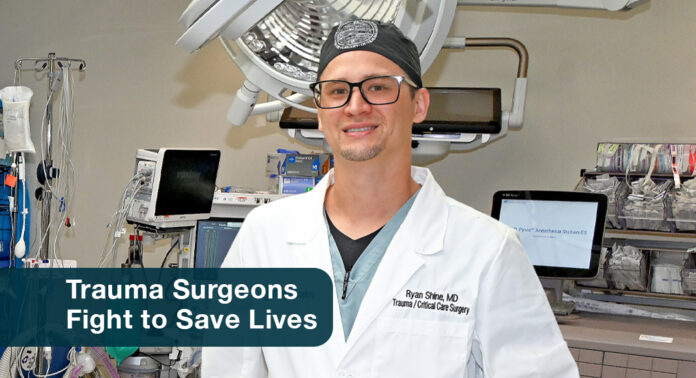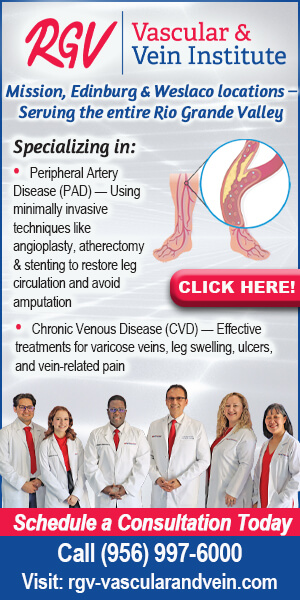Mega Doctor News
By Roberto Hugo González
An ambitious trauma initiative quietly redefines how emergency care is delivered— and lives are saved. At DHR Health, a Level I trauma center, a bold protocol known as Direct to Operating Room Resuscitation (DTOR) cuts through red tape and hesitation to meet one critical goal: stop bleeding, save lives, and beat the clock.
“It’s not a new idea,” said Dr. Ryan Shine, a trauma and acute care surgeon, surgical intensivist, and former hospital resident where he now works. “But almost nobody does it. Maybe 15, 20 centers in the entire country.”
DTOR bypasses traditional trauma flow by rerouting certain critically injured patients directly from the ambulance to the operating room, skipping the emergency department entirely. For a select group of patients with specific signs of life-threatening bleeding, this deviation from protocol could mean the difference between life and death. “We’re not trying to save every trauma patient,” Dr. Shine said honestly. “Some are simply too injured. But there’s this middle group— those who could die without immediate surgery— and those are the lives we believe we can change.”

The process hinges on early recognition. Paramedics in the field communicate with trauma teams in real time. The surgical team mobilizes instantly if a patient meets pre-established DTOR criteria and is at least five minutes out. The patient is guided through a private ambulance entrance directly into a fully stocked, 24/7 trauma OR— designated Operating Room 21— where life-saving procedures begin immediately.
“If EMS says, ‘We’ve got a gunshot to the chest, unstable vitals, we’re six minutes out,’” Shine explained, “we say, ‘Come straight to us. We’ll meet you in the OR.” No detour to triage. No pause to process. Just action.
That action can include emergency surgery or urgent interventions like inserting a chest tube to reinflate a lung. “Those are the two big killers in trauma,” Dr. Shine noted. “Severe brain injuries or bleeding you can’t control. We can’t fix the first one, but we can fix bleeding— if we’re fast enough.”
The outcomes are already encouraging. Since launching the protocol in early 2025, DHR Health has treated three patients under DTOR. One received emergency surgery, one underwent multiple life-saving interventions, and a third was ultimately stable but had met all activation criteria. “All three survived. They walked out of this hospital,” said Dr. Shine, a quiet sense of pride evident in his voice.
But this is more than a medical innovation. It’s a deeply personal mission for Dr. Shine. Raised in San Diego, he never expected to leave California. “I thought I’d be there my whole life,” he recalled. After attending undergraduate and medical school in San Diego, he joined DHR’s first general surgery residency program in 2018. He trained at DHR for five years, then completed fellowship training in trauma and surgical critical care at Baylor University Medical Center in Dallas. But before leaving Edinburg for that final year, he’d already signed a contract to return.
“Something very special happened here,” he said. “We’re not just another trauma center. We’re in a place where we can build the system, shape the policies, and innovate in real time. That doesn’t happen in places that have been doing things the same way for a hundred years.”
He credits much of that possibility to the leadership of Dr. Jeffrey Skubic, Trauma Medical Director, and the driving force behind DTOR. “This was his vision for years,” Shine explained. “We talked about it when I was still a resident. It took time. It took convincing administrators, designing protocols, building a dedicated OR, and getting ER and surgical staff on board. It’s been years in the making.”
The ask was significant. Operating rooms are among the most valuable spaces in a hospital, financially and logistically. Holding one open 24/7 for emergencies alone is a resource-intensive commitment. “But they said yes,” Shine said simply. “And now, that room is always ready— the blood’s outside the door. The equipment is open. All we need is the patient.”
While DTOR’s launch has been promising, it’s only the beginning. The team continues to gather data, fine-tune activation criteria, and hold regular meetings with ER staff to discuss feedback and refine execution. “We want this to be better, safer, and more efficient daily,” Shine said. “We’re not done.”
Beyond improving outcomes at DHR, the team hopes to scale the concept for use in other hospitals. “Not every center can build a new OR,” he acknowledged. “But we’re working on a paper showing others how to do this with what they have. What we’ve learned, what hurdles to expect, what staff need to be in place— it’s all part of the roadmap we want to share.”
For Dr. Shine, pursuing innovation is not just about medicine— it’s about humanity. He balances his career with deep commitments at home: to his wife, Cienna, and their three children, Ryerson, Holland, and Brixton. He speaks often of the sacrifices involved in 14 years of training and missed moments with his kids. “If I’m lucky enough to get a day off, the last thing I want to do is spend it away from them,” he said. “That becomes the hobby— monster trucks on the living room floor.”
Still, his work remains an extension of his values. “If we can save one life, it’s worth it,” he said. Ask the family of that patient. Ask the mother or the child who gets to walk out of here with them. Then ask if the resources, the training, the sleepless nights— if all of it was worth it.”
See related Stories:












